|
|
|
Sort Order |
|
|
|
Items / Page
|
|
|
|
|
|
|
| Srl | Item |
| 1 |
ID:
175095


|
|
|
|
|
| Summary/Abstract |
Rapid expansion of South Korean investment in Asia and Africa highlights a need to understand how local staff manage intercultural communication, particularly involving conflict with their superiors. South Korea is Vietnam’s largest investor and the Southern Key Economic Zone hosts the majority of 1252 projects and 70,000–80,000 South Koreans working in Vietnam. This paper reports on a mixed methods data set comprising 356 survey responses and nine in-depth interviews of Vietnamese workers at South Korean companies in Bình Dương province. According to workers, the main causes of conflict in workplace interactions with Korean managers are ‘differences in working culture’ – especially about workplace time use – and ‘attitude differences’. The most popular solution from both sides is to apologise. However, workers report frequently remaining silent when they are verbally abused. This research shows that intercultural communication is an ongoing and dynamic interpersonal process that is influenced by social, contextual and individual factors.
|
|
|
|
|
|
|
|
|
|
|
|
|
|
|
|
| 2 |
ID:
175098
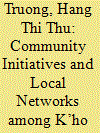

|
|
|
|
|
| Summary/Abstract |
Over the last two decades, coffee growers in Vietnam have faced the same problems as farmers all over the world. Ethnographic research among the community of K’ho Cil coffee growers in Lam Dong Province from 2016 to 2018 documented local initiatives to deal with the problems through the establishment of a K’ho Coffee network, revitalization of traditional production patterns, local integration into the global coffee commodity chain and agritourism entrepreneurship. Conceptualizing the way local K’ho Coffee growers generated and implemented the initiatives, this paper argues that by utilizing their social network, local farmers revitalized their economic production. Negotiating a decent collective position in the world system of the coffee commodity chain offers them a chance to survive the influx of economic deregulation and avert the impacts of climate change.
|
|
|
|
|
|
|
|
|
|
|
|
|
|
|
|
| 3 |
ID:
175096


|
|
|
|
|
| Summary/Abstract |
Although forest devolution has become a key strategy of forestry reforms to mobilise local resources for sustainable forest management, there is growing concern about the legitimacy of this strategy. There have been escalating disputes between forestry agencies and local people as to who receives the rights to forests. Examining the policy of forest land allocation in Vietnam helps us to understand this legitimacy issue. Research findings from three case studies show trade-offs between the two policies’ goals, environmental protection and livelihood improvement, due to locals’ low awareness of the intrinsic values of forests and their lack of knowledge regarding the policy.
|
|
|
|
|
|
|
|
|
|
|
|
|
|
|
|
| 4 |
ID:
175100
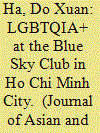

|
|
|
|
|
| Summary/Abstract |
The LGBTQIA+ (lesbian, gay, bisexual, transgender, queer, intersex, asexual) community in Vietnam faces discrimination which consequentially increases their risk of HIV infection and sexually transmitted diseases. The question is one of what practical methods might be introduced in Vietnam to strongly support the LGBTQIA+ community in protecting and maintaining health for themselves, their families, and society. How will advice best be delivered? To answer these questions, we conducted research at the Blue Sky Club in Ho Chi Minh City. We evaluate the effectiveness of health education communications and recognize that the LGBTQIA+ community has a different perspective on discrimination to the majority, and they consider discrimination a motivating force in their lives. This research takes account of the diversity of sexual orientation in the LGBTQIA+ community and yet acknowledges their desire is to be equally recognized by society.The LGBTQIA+ (lesbian, gay, bisexual, transgender, queer, intersex, asexual) community in Vietnam faces discrimination which consequentially increases their risk of HIV infection and sexually transmitted diseases. The question is one of what practical methods might be introduced in Vietnam to strongly support the LGBTQIA+ community in protecting and maintaining health for themselves, their families, and society. How will advice best be delivered? To answer these questions, we conducted research at the Blue Sky Club in Ho Chi Minh City. We evaluate the effectiveness of health education communications and recognize that the LGBTQIA+ community has a different perspective on discrimination to the majority, and they consider discrimination a motivating force in their lives. This research takes account of the diversity of sexual orientation in the LGBTQIA+ community and yet acknowledges their desire is to be equally recognized by society.
|
|
|
|
|
|
|
|
|
|
|
|
|
|
|
|
| 5 |
ID:
175092
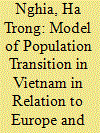

|
|
|
|
|
| Summary/Abstract |
This paper analyses the population transition model for Vietnam, based on Grover’s five stages of population transition. Compatible with the transitional model of Western Europe and other advanced Asian countries, this process in Vietnam has some significant differences: (a) the initial shift or transition of fertility of the population in Vietnam is later than in Asian countries by about 13 years while compared to Europe it is nearly 108 years later; and (b) while the period of initial transition of mortality in Vietnam may not be very different from other Asian countries, it is more than 100 years later than in European countries, especially those in Western Europe. One of the main factors influencing the late transition of Vietnam’s population process is, of course, colonialism and the consecutive wars (1945–1954 and 1955–1975). After 1975, Vietnam’s population was stable as industrialisation and urbanisation led to the development of health services, education and an urban lifestyle, as well as effective population policies.
|
|
|
|
|
|
|
|
|
|
|
|
|
|
|
|
| 6 |
ID:
175097
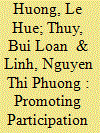

|
|
|
|
|
| Summary/Abstract |
This paper focuses on local people’s participation in the development of ecological cultural tourism in the Vam Nao reservoir area of An Giang Province, located approximately 180 kilomteres southeast of Ho Chi Minh City, Vietnam. Building on experiences of several countries on how to involve local people in natural resource management and ecotourism development, we interviewed 95 in-depth stakeholders related to natural resource management, tourism, environment, and people’s participation; distributed questionnaires to 340 tourists; and synthesised field survey data from 500 online visitor surveys. On the basis of analysis and evaluation of these materials, this paper suggests a new policy on tourism for An Giang provincial leaders involving preservation of local cultural values as support for ecological and cultural tourism in the studied area. In the last section, the paper makes recommendations for increasing community participation in areas similar to the one studied herein.
|
|
|
|
|
|
|
|
|
|
|
|
|
|
|
|
| 7 |
ID:
175094
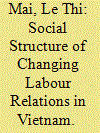

|
|
|
|
|
| Summary/Abstract |
Industrial action in export processing zones challenges the conventions of labour protest. Labour relations in domestic and foreign direct investment enterprises in industrial parks and export processing zones in Ho Chi Minh City were researched in 2018, with findings that divide into two areas of interest: (a) the ways ‘innovation’ in the economy has affected changes for the subjects involved in labour relations; (b) with strikes being a manifestation of conflict in labour relations, after a period of sharp increase (2011), there has been a decreasing number in recent years, but with changing characteristics. In particular, when a strike occurs now, the trade union which used to be the unique legal representative of all Vietnamese employees is less often favoured, and others are chosen by the employees to negotiate with the business owner. This trend will perhaps be formalized as Vietnam implements international labour–trade union commitments recently adopted.
|
|
|
|
|
|
|
|
|
|
|
|
|
|
|
|
| 8 |
ID:
175091


|
|
|
|
|
| Summary/Abstract |
In 1975, when Saigon, now Ho Chi Minh City, was liberated and the Americans, Australians and other colonial armies had gone home, Vietnam set about reconstruction. It will not be a surprise to anyone who might have reflected upon the consequence of long and brutal wars that the immediate post-war years were difficult. Setting aside the small matter of military incursions from neighbouring states, an economic embargo led by the US and in place until 1994, and a stagnant global economy heading towards a long recession and the successive dilemmas of the 1997 Asian financial crisis, the 2000–2001 tech/dot.com bubble and the 2008 sub-prime crash, already since 1986 Vietnam had introduced economic reforms – Đổi Mới – that had put it on a path leading eventually to significant and consistent growth and optimism that even Covid-19 does not seem to hugely diminish (which of course remains to be seen).
|
|
|
|
|
|
|
|
|
|
|
|
|
|
|
|
| 9 |
ID:
175099


|
|
|
|
|
| Summary/Abstract |
A smart travel brand today is not only an advertising marketing channel but also requires businesses to adapt and focus on brand value. Branding plays a role in shaping customer search behavior which means an effectively personalized brand helps travel businesses find potential customers and develop specific services to maintain business advantages. This article contributes some ideas about building a tourism brand today that is personalized through story and awareness in the context of digital competition, where customers play a central role both of providers of recommendations and consumers of the recommended story.
|
|
|
|
|
|
|
|
|
|
|
|
|
|
|
|
| 10 |
ID:
175093


|
|
|
|
|
| Summary/Abstract |
Saigon-Ho Chi Minh City (HCMC) is a typical 21st-century mega-city coping with informal hyper-growth. Government planners are under pressure to provide mass housing, transit and utilities. Yet HCMC has developed a distinctive and effective homegrown informal housing system based on ‘tube housing’. This system of dense housing, motorcycle transport and laneways embodies an integrated everyday urban culture whereby each of its purposes (work, commerce, rest and recreation) in turn shapes the whole urban form. As such, it is argued that these everyday forms of urbanism should be respected and incorporated by city planners into their masterplans rather than be viewed as anachronistic, illegal forms to be overcome and deconstructed.
|
|
|
|
|
|
|
|
|
|
|
|
|
|
|
|
|
|
|
|
|